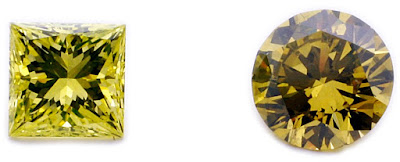The twin issues here are: Valuation & Disclosure.
What is HPHT?

HPHT can "de-colorize" pale yellowish diamonds.
High pressure and high temperature in the earth make the diamond. In a lab, high temperature and high pressure (HPHT) can change a diamond's color or even create a diamond.
Exposing a diamond of weak or unattractive color to extremes of pressure and temperature can vastly improve its appearance. The treatment can de-colorize pale yellow diamonds, improving their color grade from H to F, for example. It can also change unattractive brownish diamonds into radiant blues, greens, yellows, and even the difficult but very desirable reds.

HTHP treatment has been around for a dozen years and the color changes it produces are considered to be permanent. Some brands specialize in this process, offering lushly colored diamonds at a fraction of the price of natural "fancies."
Because of the huge price difference between natural and treated diamonds, disclosure is essential.

HPHT can produce vibrant colors.
Is HPHT a Treatment? YES
Brands that sell HPHT diamonds prefer to avoid using the word "treatment" because of its associations. Like treating an illness, treating a gemstone suggests that something was wrong with the gem, and that requires more explanation and results in buyer hesitation.
Instead, companies using HPHT talk about unmasking or revealing Nature's colors. Bellataire, an early developer of HTHP treatment, was influential in getting GIA to use on its certificates the phrase "HTHP Process," rather than "HPHT Treatment."
The FTC requires disclosure of gem treatments. Whether called a treatment or a process, HPHT should be disclosed on the appraisal, the diamond certificate, and the sales receipt.
Are the labs being "tested"?
Laser inscription on diamond's girdle says the stone is color-treated.
Over the past decade, the jewelry industry has promoted disclosure practices around HTHP. Early producers of color-enhanced gems were proud of their accomplishment and laser-inscribed their brand on the girdle of the diamond. GIA's protocol is to require laser inscriptions, either with the brand name or with words such as "HPHT Processed" or "Irradiated," before the diamonds are submitted for grading.
The current problem is that labs have been receiving HPHT–treated diamonds without such inscriptions-that is, without disclosure. Also, they are receiving larger diamonds than previously. This suggests that new companies are using different versions of HTHP and "testing" the labs, to see if the labs are able to detect the treatment.
New gem enhancements are always under development and old methods are constantly being refined and improved. Sophisticated analysis relies on specialized equipment for detecting enhancements, just to keep up with gem-treatment technology. It's only the major grading labs that can afford much of this equipment; the averahttp://www.blogger.com/img/blank.gifge jeweler cannot.
GIA is contacting its clients both to learn the source of the treated diamonds and to remind them that failure to disclose treatment at all stages of the pipeline–dealer, distributor, and retailer–is unacceptable. The lab is also reviewing each transaction to determine whether it's appropriate to turn over relevant information to trade organizations and law enforcement bodies.
Source: JCRS

No comments:
Post a Comment
Note: Only a member of this blog may post a comment.